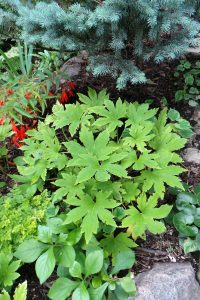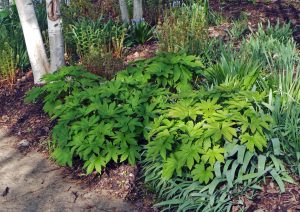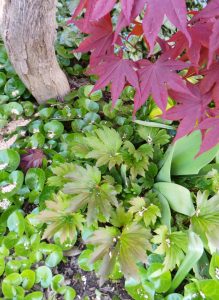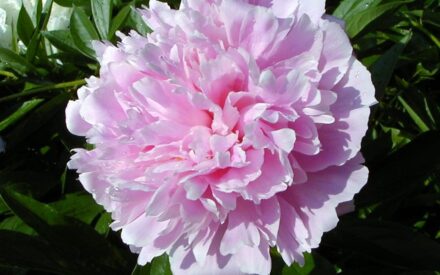
Mukdenia (=Aceriphyllum) rossii is one of just two species in this genus of herbaceous perennials native to rocky slopes and ravines of eastern China and Korea that commemorates the ancient city of Mukden, the Chinese capital city of the Manchu dynasty. Hardy in zones 4 to 8 (possibly to zone 3), this distinctive looking plant with a common name of mukdenia is in the saxifrage family (Saxifragaceae) and superficially resembles the distantly related North American genus Heuchera.
Mukdenia forms a small mound of thickly textured, glossy foliage up to a foot tall and 1 to 2 feet wide, spreading slowly over time by short creeping rhizomes. The rounded, palmate leaves up to 5 inches across are lobed and dentate. The fan-shaped leaves emerge a deep coppery-bronze in spring, becoming medium to dark green in summer with reddish color creeping inward from the edges by the end of the summer. Under ideal conditions, the leaves become a rich burgundy color with reddish orange highlights on their margins by fall. The plants are deciduous, with the foliage declining in late fall or early winter and new leaves emerging from the crown the following spring.

In spring tiny white star-shaped flowers are produced soon after leaves emerge from rosy-blushed, crowded bud spikes. The slender, leafless, dense, branched panicles are held well above the foliage and remain intact (if not deadheaded). The flowers fade to pale pink and eventually to brown after a few weeks and are followed by inconspicuous brown fruits.


This ornamental plant is often used as a ground cover with several planted together, or as a fall accent plant in woodland gardens or the front of beds and edges of shady borders. It combines well with Japanese forest grass (Hakonechloa macra) for contrast in texture, habit and, especially the gold or variegated varieties, color. It also mixes well with blue or gold hostas, wild gingers (Asarum spp.) and smaller ferns. This plant can also be grown in containers (but will need some winter protection in colder climates, such as moving into an unheated garage).

Mukdenia grows best in afternoon shade in moist, fertile well-drained soil, although it can tolerate full sun in cooler regions, especially where the soil remains moist. Although it will grow in more dense shade, the attractive red fall color will not be as intense. It has few insect or disease problems, although slugs can be a problem in moist conditions. It is not favored by deer or rabbits. The old foliage of this low maintenance plant is best cleaned up in early spring before it resumes active growth for the season. It can be propagated by division in spring, best done just before the leaf buds expand. Seeds should be sown in fall for stratification over the winter.
The most commonly offered mukdenia is the cultivar ‘Karasuba’, also marketed as Crimson Fans™, a selected form from Japan, with larger leaves more pronounced crimson red color along the leaf tips throughout summer than the species. ‘Starstream’ is a variegated form.
– Susan Mahr, University of Wisconsin – Madison





 Aster, Symphyotrichum spp.
Aster, Symphyotrichum spp. Alternatives to Lawn: Groundcovers
Alternatives to Lawn: Groundcovers Peony
Peony Create a Butterfly Garden
Create a Butterfly Garden


